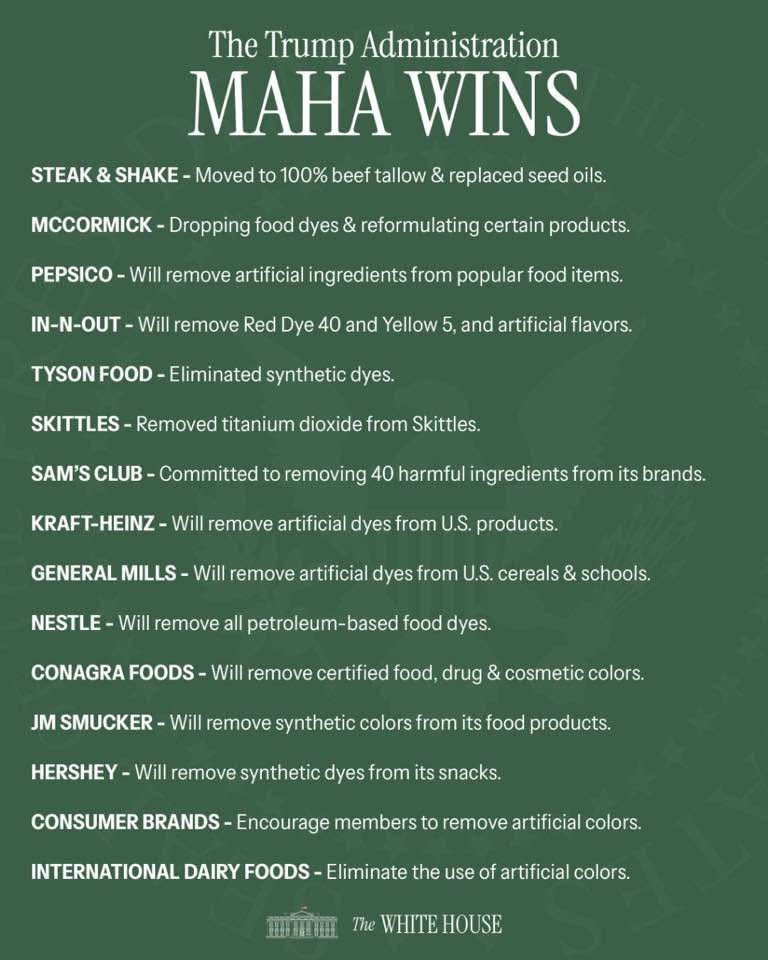
MAHA Wins or Just Marketing?
- doctriss
- Jul 17
- 3 min read
What These Corporate Changes Really Mean — And Why Canadians Should Pay Attention
A reminder that awareness isn’t enough—we must act in alignment with what we now know.
Recently, a viral image has been making the rounds—celebrating what’s being called a “MAHA Win” (Make America Healthy Again). It lists major food corporations that are beginning to remove artificial dyes, petroleum-based colors, synthetic ingredients, and other toxic additives from their products.
Whether these changes came from consumer pressure, lawsuits, or political influence, one thing is clear:
People are waking up.
But before we celebrate, let’s pause. Because while these changes may be taking root in the U.S., many of these companies are still selling the same harmful ingredients in Canada.
Let’s take a deeper look at what each company has done—and why it matters for your health, your family, and your future.
Companies & Their Past Harmful Practices
Steak & Shake
Change: Switched to beef tallow, removed seed oils.
Why it matters: Industrial seed oils like soybean and canola can cause chronic inflammation and accelerate aging.
McCormick
Change: Dropping artificial dyes.
Why it matters: Red 40 and Yellow 5 are linked to behavioral issues and allergic reactions in sensitive individuals.
PepsiCo
Change: Removing artificial ingredients.
Why it matters: From sodas to snacks, synthetic additives disrupt the nervous system and endocrine function.
In-N-Out
Change: Cutting Red Dye 40, Yellow 5, and artificial flavors.
Why it matters: These additives are banned in Europe but still sold in Canada and the U.S.
Tyson Foods
Change: Eliminated synthetic dyes.
Why it matters: Processed meats often contain cancer-linked preservatives and disrupt digestion.
Skittles (Mars Inc.)
Change: Removed titanium dioxide.
Why it matters: This whitening agent is banned in the EU as a possible carcinogen—yet still found in many Canadian candies.
Sam’s Club (Walmart)
Change: Removing 40 harmful ingredients.
Why it matters: This includes preservatives that impair hormonal health and neurological function.
Kraft-Heinz
Change: Removing artificial dyes in U.S. products.
Why it matters: The same Kraft Dinner you see in Canada often contains dyes banned elsewhere.
General Mills
Change: Removing dyes from cereals and school foods.
Why it matters: Kids are especially vulnerable to synthetic dyes, sugar, and GMOs.
Nestlé
Change: Cutting petroleum-based dyes.
Why it matters: These dyes are neurotoxic and unnecessary—especially in children’s snacks.
ConAgra Foods
Change: Removing certified food, drug, and cosmetic colors.
Why it matters: These coal tar-derived dyes are banned in other countries due to toxicity.
JM Smucker
Change: Removing synthetic colors.
Why it matters: Visual appeal should not outweigh health impact, especially in products marketed to kids.
Hershey
Change: Removing synthetic dyes from snacks.
Why it matters: Linked to hyperactivity and attention issues.
Consumer Brands Association
Change: Encouraging members to remove artificial colors.
Why it matters: Industry acknowledgment is an important first step—but accountability is key.
International Dairy Foods
Change: Eliminating artificial colors.
Why it matters: Milk, yogurt, and ice cream shouldn’t be neon or chemically enhanced.
🇨🇦 How This Relates to Canada
Here’s the uncomfortable truth:
Canada is still allowing many of these banned ingredients in our food supply.
❗ Two-Tiered Formulas
Brands like Kraft, PepsiCo, Nestlé, and McCormick create safer versions of their products for Europe—and now the U.S.—while still selling dye-filled, chemical-laden formulas in Canada.
❗ Canadian Implications
No national ban on Red 40, Yellow 5, titanium dioxide, or petroleum-based dyes.
Children, seniors, and already burdened bodies are paying the price.
The only way to stop it is for we the people to demand better.
What You Can Do in Canada
Read every label. If you see “color,” “flavor,” or numbers—ask questions.
Email or call brands. Ask if their Canadian formulas have been updated too.
Support small farms & PMAs. Private associations and local food co-ops bypass toxic food systems.
Educate your community. Share what you learn in plain language.
Vote with your wallet. They listen when we stop buying.
Would You Join Me in Leading Change?
I’m considering forming a group—both online and in person—to help:
Write polite but firm letters to companies and government officials
Encourage product reformulation in Canada
Draft private paperwork and notices for lawful and informed living
Create community templates for public and private pressure
We don’t need to yell. We need to unify.
If this speaks to you, I’d love to hear:
Would you participate in a letter-writing or awareness campaign?
What skills, time, or energy could you contribute?
If this resonates, please share this post, comment, or send me a message.
Let’s show them that Canadians care too—and we’re watching.
For the health of our children, our elders, and the land we call home… it’s time.
Are you in?






Comments